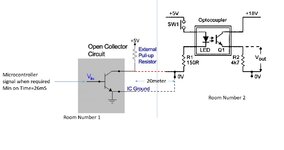Bjtpower_magic
Full Member level 1
Hello Everyone,
I need your help to understand explanation on below.

Optocoupler-We are using detector (Diode) stage here
Transistor switch will on when we give commands so it is not continuous frequency signal.
Black (Bottom)- is common GND for Switch and Optocoupler
What are the probable reason i need to look into for wire selection? if i use shielded cable then where i can connect or keep it open>
Marx
I need your help to understand explanation on below.
Optocoupler-We are using detector (Diode) stage here
Transistor switch will on when we give commands so it is not continuous frequency signal.
Black (Bottom)- is common GND for Switch and Optocoupler
What are the probable reason i need to look into for wire selection? if i use shielded cable then where i can connect or keep it open>
Marx

